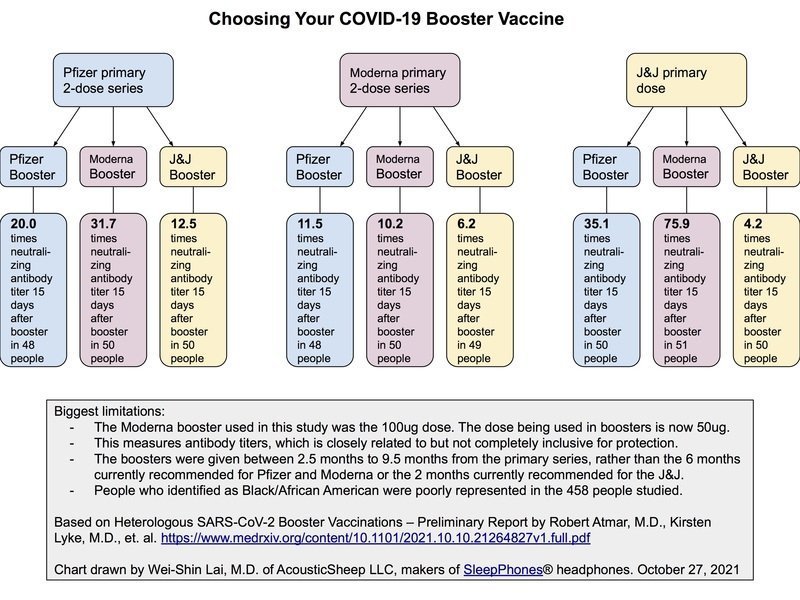Information for My Friends Who Are Considering Booster Doses

Choosing a COVID-19 Booster Vaccine
Anyone who received the J&J vaccine at least 2 months ago can get any booster.
If you received the Pfizer or Moderna primary series at least 6 months ago (for the second dose), you can get a booster if you are...
-
Age 65+
-
Age 18+ who work or live in high-risk settings (healthcare, emergency response, schools and universities, childcare, food, manufacturing, corrections, postal service, public transit, grocery store, congregate care, homeless shelter)
-
Age 18+ who have an underlying condition (cancer, chronic kidney disease, chronic liver disease, chronic lung disease, dementia or neurological conditions, DIABETES type 1 or 2, Down syndrome, heart conditions, HIV, immunocompromised state, DEPRESSION, mental health condition, OVERWEIGHT, obesity, pregnancy, sickle cell, thalassemia, SMOKING current or former, organ or stem cell transplant, stroke, cerebrovascular disease, substance use disorder, alcoholism, or tuberculosis)
These criteria are quite broad, and many people who may not think they qualify actually do. Last Friday, the CDC authorized all three types of vaccines (Pfizer, Moderna, and J&J) as a booster. So which one should you choose? Here is the study data.

The higher the neutralizing antibody titer rises the better. For example, if you received the Pfizer primary vaccine series, getting another Pfizer dose will increase your antibody level from 20 IU/ml to 400 IU/ml (20.0 times the original). However, if you receive the Moderna booster, your antibody levels may rise to 634 IU/ml (31.7 times the original). If you get the J&J booster, your level may only reach 250 IU/ml (12.5 times the original). It's clear from the chart that boosting with either the Pfizer or the Moderna vaccine is better than boosting with the J&J. Should you choose the Pfizer or the Moderna for your booster? Here is a copy of the side effect chart published by the study preliminary report.

Boosting with the J&J caused many side effects. Considering the relatively poorer antibody response and the high side effect profile, I do not recommend boosting with the J&J unless that's the only option available for you. Boosting with the Pfizer gives good antibody responses and fewer side effects compared with the Moderna. However, the Moderna dose used in this study was 100μg, rather than the currently recommended 50μg. It's possible that the Moderna 50μg booster is roughly equivalent to the Pfizer efficacy and side effect profile.
I had the Moderna primary series. I chose the Pfizer booster because it had fewer side effects and better efficacy according to this study. We are currently advising people who are getting their boosters to expect similar reactions to their second dose, if it's the same brand. For most people, the side effects include a sore arm, fatigue, and a headache for about 1-2 days. As long as expectations are appropriate, most people are very thankful to receive a free life-saving vaccine.
Some of my friends and family worry that they are "cutting in line" or taking a vaccine "that should be donated to a developing country."
I have been volunteering at a federally-funded vaccine clinic since April. We love being busy. We worry when it gets quiet. During May, the number of people coming in for vaccines dropped precipitously. June through August was extremely quiet. We might give a dose an hour sometimes. We had to destroy a few thousand doses over the summer because they expired. When Pfizer was approved for ages 12-15, we saw some kids, but definitely no long lines. When Pfizer was formally FDA approved, there was no bump at all in the number of people getting shots. When third doses were approved for immunocompromised people, we saw a few people. There just aren't many truly immunocompromised people out there. We had another batch of vaccine doses we had to destroy due to expiration. When the Pfizer boosters were approved, we finally got lines again for 2 weeks. The lines were mostly because we were short on vaccinators and pharmacists. Most of our response team was called away to run COVID testing at long-term care facility outbreaks or hospital N95 mask fit-testing. Now that boosters are approved for even more people, including people who received the Moderna or J&J previously, it's been busy again. Hopefully it will continue to be busy when the 5-11 year olds can get their vaccine doses. All of this is to say that the line is very short, and we want you in line if you want to be. Don't worry about "cutting in line" because you're not.
There's more than enough vaccine to dose and boost everyone in the US. Every time we waste a dose, it hurts the world. If it was easier to store and transport the vaccines, then a reverse logistics operation may help the developing countries with getting doses. However, both the Pfizer and the Moderna vaccines require very cold transport and storage. We would have to gather up small batches of near-expiration vaccines, label with cold-storage detailed information including temperature excursion history, carefully pack them in chilled containers, and deliver them to a centralized location. Then that place would have to be re-package and ship to a developing country that may not have reliable roads for efficient transportation, consistent electricity for freezing stuff, or organized manpower to deliver inconsistently available finicky vaccines.
The Pfizer vaccine is stored in dry ice at -76F. It can only be stored at normal freezer temperatures for up to 2 weeks. An "opened" vial of the Pfizer vaccine expires in 6 hours, and each vial has 6 doses. It has to be mixed with sterile saline (supplied separately) prior to administration. The Moderna vaccine has to be stored in a freezer, not dry ice. An "opened" vial of the Moderna vaccine expires in 12 hours, and there are up to 11-15 regular doses per vial. There are up to 30 booster doses per vial, but a vial can only be punctured 20 times. If this feels like too much information already, then you can imagine how difficult it is to manage a logistics chain that's three times as long as initially devised. It's extremely difficult to re-gather previously distributed vaccine doses and ship them to a developing country with good cold-chain logistics. This problem is mainly for the Pfizer and Moderna mRNA vaccines.
There is actually a great vaccine that's much easier for use in developing countries. The AstraZeneca vaccine (widely distributed in the European Union) which uses technology similar to the Johnson and Johnson vaccine is far easier to transport and store. It only requires refrigeration for storage, and opened vials can be kept in a refrigerator and used for up to 2 days. Plus, it's a much cheaper vaccine at well under $10 a dose compared with $30-50 a dose for the mRNA vaccines. A developing country short on resources would actually be better served by an easy-to-use vaccine like the AstraZeneca. Don't worry about saving vaccine doses for the rest of the world. You can't at an individual level.
If you get a vaccine booster, you are far less likely to catch COVID-19 or spread it to others. You are also far less likely to develop symptomatic disease, be hospitalized, or die from COVID-19. Less viral burden worldwide means less chance for the virus to mutate to a worse strain. Will yearly boosters be necessary in the future? It's likely that a yearly booster would be recommended. Dosing may not need to be as high though, and it may be able to be combined with the flu vaccine. Both Pfizer and Moderna are working on mRNA flu vaccines. I expect that by 2023, we will have a combined flu and COVID vaccine in the works. We'll have to keep an eye on variants and try our best to reduce them from developing by quickly vaccinating as much of the world as possible. Hopefully with the kids vaccinations coming and most people having developed immunity either through vaccination or disease, we won't have severe waves of disease and we can get to a new normal by the summer of 2022.
